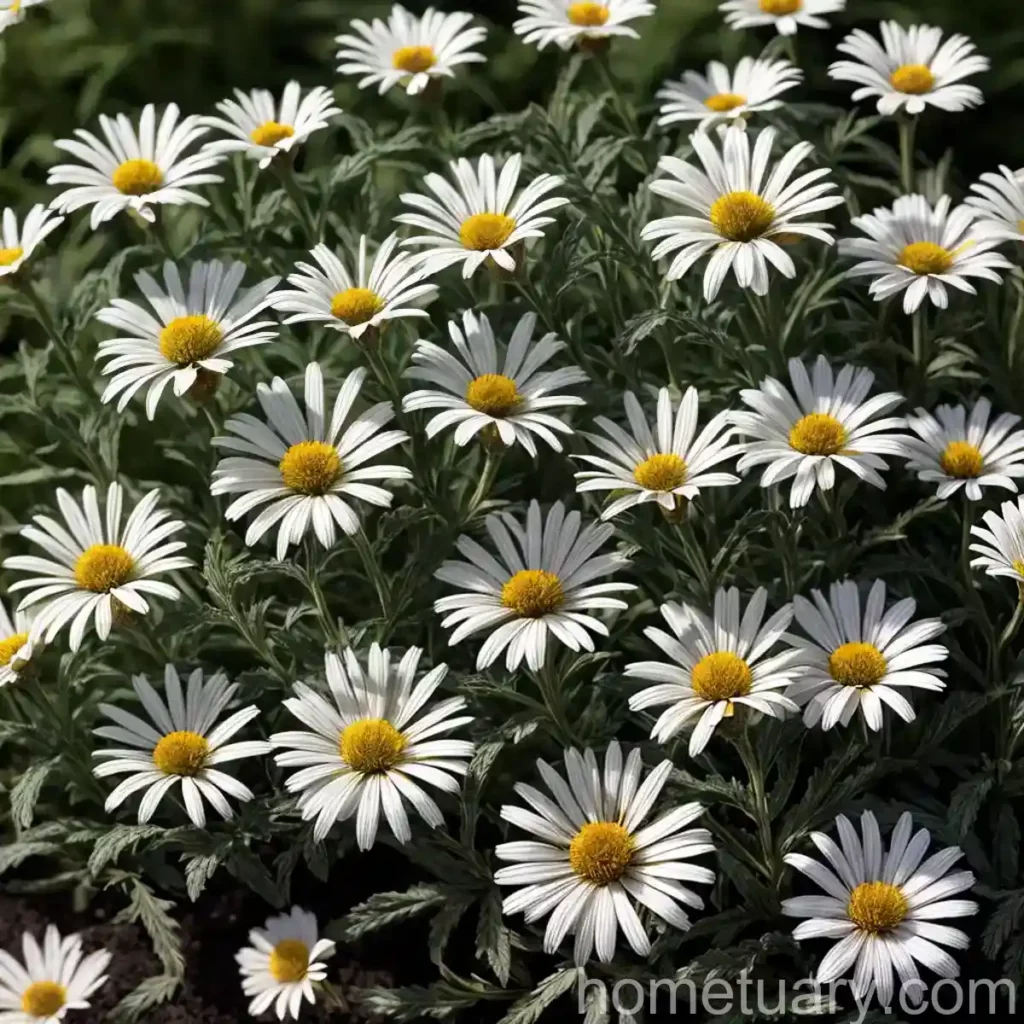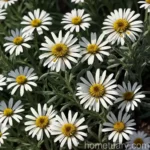Shasta Daisy (Leucanthemum x superbum ‘Amelia’) – A Complete Guide
In the world of horticulture, few plants can match the timeless beauty and charm of the Shasta daisy (Leucanthemum x superbum ‘Amelia’). With its creamy white petals surrounding a golden yellow center, this perennial flower has been a beloved garden favorite for decades. In this comprehensive guide, we will delve into the culture, uses, care, maintenance, and interesting facts about the Shasta daisy. Whether you are a seasoned gardener or a novice plant enthusiast, this guide will provide you with all the essential information to cultivate and appreciate this stunning flower.
What is a Shasta Daisy?
The Shasta daisy, scientifically known as Leucanthemum x superbum ‘Amelia’, is a hybrid flower that belongs to the Asteraceae family. It is a cross between several species of daisies, resulting in a plant that combines the best traits of its parent plants. The Shasta daisy is characterized by its large, showy blooms and vigorous growth habit, making it a popular choice for gardens, borders, and floral arrangements.
Key Takeaways
Before we delve deeper into the specifics of the Shasta daisy, here are some key points to keep in mind:
- Scientific Name: Leucanthemum x superbum ‘Amelia’
- Common Name: Shasta Daisy
- Plant Type: Perennial Flower
- Hardiness Zones: 5-9
- Mature Height: 18-24 inches
- Mature Spread: 12-18 inches
- Bloom Time: Late spring to early summer
- Exposure: Full sun to partial shade
- Soil Type: Well-drained, fertile soil
- Watering: Regular watering, especially during the growing season.
Now let’s explore the different aspects of caring for and appreciating the beauty of the Shasta daisy.
Culture of Shasta Daisy
The culture of Shasta daisies encompasses the environmental conditions, care practices, and growing requirements that are essential for nurturing healthy and vibrant plants. Understanding the culture of this perennial flower is crucial for successfully integrating it into your garden or landscape.
Water
Proper watering is essential for the health and vitality of Shasta daisies. These plants thrive in moist, well-drained soil, especially during the active growing season. While they are relatively drought-tolerant once established, consistent watering is necessary for promoting robust growth and prolific blooming.
Watering Tips for Shasta Daisies:
- Water the plants deeply, allowing the soil to dry out slightly between waterings.
- Apply water at the base of the plants to avoid wetting the foliage, which can lead to fungal diseases.
- During periods of extended dryness, provide supplemental irrigation to keep the soil consistently moist.
Sunlight
Shasta daisies are sun-loving plants that perform best when grown in full sun. They require a minimum of 6-8 hours of direct sunlight each day to thrive and produce abundant blooms. In areas with hot summers, some afternoon shade can benefit the plants, especially during the peak of the summer heat.
Sunlight Requirements for Shasta Daisies:
- Choose a planting location that receives ample sunlight throughout the day.
- In regions with intense afternoon sun, consider providing light shade during the hottest part of the day.
- Monitor the sun exposure in your garden and adjust the planting location accordingly to ensure optimal growing conditions for the daisies.
Fertilizer
Feeding Shasta daisies with a balanced fertilizer can enhance their growth and blooming potential. These plants benefit from regular applications of a well-balanced, granular fertilizer formulated for flowering perennials. Fertilize in early spring as the plants emerge from dormancy, and then again in midsummer to support continued growth and blooming.
Fertilizing Guidelines for Shasta Daisies:
- Use a balanced, slow-release fertilizer with an N-P-K ratio of 10-10-10 or similar formulation.
- Apply the fertilizer around the base of the plants, avoiding direct contact with the foliage.
- Water the plants thoroughly after fertilizing to help distribute the nutrients into the soil.
Soil
The soil composition plays a crucial role in the overall health and performance of Shasta daisies. These plants thrive in well-drained, fertile soil that provides a stable foundation for their root systems. Amending the soil with organic matter can improve its structure and fertility, creating an ideal growing environment for the daisies.
Soil Requirements for Shasta Daisies:
- Choose a well-drained planting site to prevent waterlogging and root rot.
- Incorporate compost or well-rotted manure into the soil to improve its organic content and nutrient levels.
- Perform a soil test to assess the pH and nutrient levels, and make adjustments as needed to create optimal growing conditions for the daisies.
Pruning
Pruning is an essential aspect of Shasta daisy maintenance, as it helps to promote tidy growth, encourage blooming, and rejuvenate the plants. Regular deadheading and selective pruning can prolong the blooming period and prevent the plants from becoming overgrown or leggy.
Pruning Guidelines for Shasta Daisies:
- Deadhead spent flowers regularly to encourage the production of new blooms.
- Trim back the foliage and spent flowering stems in late summer to tidy up the plants and promote a neater appearance.
- Divide the plants every 2-3 years to rejuvenate older clumps and maintain their vigor.
Propagation
The propagation of Shasta daisies allows gardeners to expand their plant collection, share their favorite varieties with others, and rejuvenate older plants. This perennial flower can be propagated through various methods, including division, seed sowing, and cutting propagation.
Propagation Techniques for Shasta Daisies:
- Division: Divide established clumps of Shasta daisies in early spring or fall to create new plants.
- Seed Sowing: Collect seeds from mature Shasta daisy plants and sow them indoors or directly in the garden.
- Cutting Propagation: Take stem cuttings from healthy plants and root them in a suitable growing medium to produce new plants.
Container Popularity
Shasta daisies are well-suited for container cultivation, allowing gardeners with limited space to enjoy their charm and beauty. When grown in containers, these perennial flowers can grace patios, balconies, and small urban gardens, adding a touch of natural elegance to any outdoor space.
Advantages of Container Cultivation:
- Versatility: Shasta daisies can be grown in various container sizes, from small pots to larger decorative planters.
- Portability: Containers offer the flexibility to move the plants to different locations based on sunlight and aesthetic preferences.
- Ornamental Value: The bright blooms and lush foliage of Shasta daisies make them an attractive addition to outdoor living areas and landscape designs.
Common Diseases
Despite their overall resilience, Shasta daisies can be susceptible to certain diseases that can affect their health and appearance. Understanding the common diseases that can afflict these plants is important for implementing preventive measures and prompt treatment when necessary.
Common Diseases of Shasta Daisies:
- Powdery Mildew: A fungal infection that appears as a powdery white coating on the leaves and stems.
- Leaf Spot: Caused by various fungal pathogens, resulting in dark, water-soaked spots on the foliage.
- Root Rot: Excessive soil moisture can lead to root rot, causing the plants to wilt and decline.
Disease Diagnosis
Diagnosing and addressing diseases in Shasta daisies requires careful observation and prompt intervention to protect the overall health of the plants. Identifying the symptoms and signs of common diseases is essential for implementing targeted treatment and prevention strategies.
Tips for Disease Diagnosis:
- Monitor the plants regularly for any unusual changes in growth, foliage color, or overall appearance.
- Investigate any signs of powdery mildew, leaf spots, or wilting to identify potential diseases affecting the daisies.
- Consult with local gardening experts or extension services for accurate diagnosis and treatment recommendations.
Common Pests
While typically resilient to pest infestations, Shasta daisies can attract certain insects that may affect their growth and vitality. Recognizing and managing common pests is essential for safeguarding the plants and preserving their ornamental value in the garden.
Common Pests Affecting Shasta Daisies:
- Aphids: Small, soft-bodied insects that cluster on the undersides of leaves, sucking plant sap and causing distortion.
- Thrips: Tiny, slender insects that feed on flower buds and cause stippling on the petals and leaves.
- Spider Mites: Nearly microscopic pests that spin fine webs and suck the plant juices, leading to discoloration and leaf drop.
Botanist’s Tips
For aspiring botanists and plant enthusiasts, the Shasta daisy offers numerous opportunities for observation, experimentation, and appreciation. Studying the botanical characteristics and growth habits of these perennial flowers can provide valuable insights into the complexities of plant life and ecosystem dynamics.
Botanist’s Tips for Studying Shasta Daisies:
- Conduct detailed observations of the plant’s growth, reproductive structures, and interactions with pollinators.
- Experiment with different soil compositions, water regimes, and light conditions to observe their impact on the daisies’ growth and blooming patterns.
- Document the lifecycle of the plants, from seed germination and seedling development to flowering and seed production.
Fun Facts
Beyond their ornamental value and cultural significance, Shasta daisies are rich in interesting and unique characteristics that make them a fascinating subject for exploration. Learning about the fun facts and historical aspects of these plants can deepen our appreciation for their timeless allure.
Fun Facts about Shasta Daisies:
- The first Shasta daisy was developed by renowned plant breeder Luther Burbank in the late 19th century.
- Shasta daisies are known for their excellent cut flower qualities, making them popular choices for floral arrangements and bouquets.
- The name “Shasta daisy” is derived from the majestic Mount Shasta in California, where Luther Burbank developed and cultivated the original hybrid.
Links to External Resources
To further enrich your knowledge and appreciation of Shasta daisies, I recommend exploring the following external resources:
- The American Daisy Society: An organization dedicated to the preservation and promotion of daisy varieties, including the Shasta daisy.
- University Extension Services: Extension articles and guides on perennial flower production, including specific information on Shasta daisies.
- Botanical Gardens and Arboreta: Visit local botanical gardens and arboreta to view Shasta daisies in various landscape settings and gather inspiration for your own garden designs.
In conclusion, the Shasta daisy (Leucanthemum x superbum ‘Amelia’) stands as a testament to the enduring appeal of garden flowers. Its timeless beauty, resilience, and adaptability make it a cherished addition to gardens, landscapes, and floral arrangements around the world. By understanding its culture, care requirements, and unique characteristics, we can continue to celebrate and preserve the natural splendor of this iconic perennial flower.















